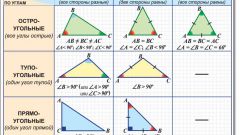Instruction
1
If you know the lengths of the sides (a and b) of the triangle forming the bisected angle (γ), the length of the bisector (L) can be derived from the spherical law of cosines. To do this, find the value of twice the product of the lengths of the sides into the cosine of half the angle between them and divide the result by the sum of the lengths of the sides: L=2*a*b*cos(γ/2)/(a+b).
2
If the size of the angle which divides the angle bisector, is unknown, but given the lengths of all sides of the triangle (a, b and c), for calculations it is more convenient to introduce an additional variable properiter: p=½*(a+b+c). After this part of the formula length of a bisecting line (L) from the previous step it will be necessary to replace in the numerator of the fraction put a doubled square root of the product of the lengths of the sides, forming separated by the bisector of the angle at properiter and a quotient of the subtraction of properiety length third party. Leave the denominator unchanged - this should be the sum of the lengths of the sides of the split angle of the triangle. As a result, the formula should look like this: L=2*√(a*b*p*(p-c))/(a+b).
3
If to complicate radical expression formulas from the previous step, it is possible to do without properiety. To do this, leave the denominator (the sum of the lengths of the sides of the split angle) unchanged, and the numerator shall be the square root of the product of the lengths of these sides to the sum of their lengths, from which is subtracted the length of the third side and the sum of the lengths of all three sides: L=√(a*b*(a+b-c)*(a+b+c))/(a+b).
4
If the baseline is not given only the lengths of the sides (a and b), forming separated by the bisector of the angle, but the lengths of segments (d and e), in which the bisector was shared by a third party, you also have to take the square root. The length of the bisecting line (L) in this case count as the root of the product of the lengths of the known sides, from which is subtracted the product of the lengths of the segments: L=√(a*b-d*e).



